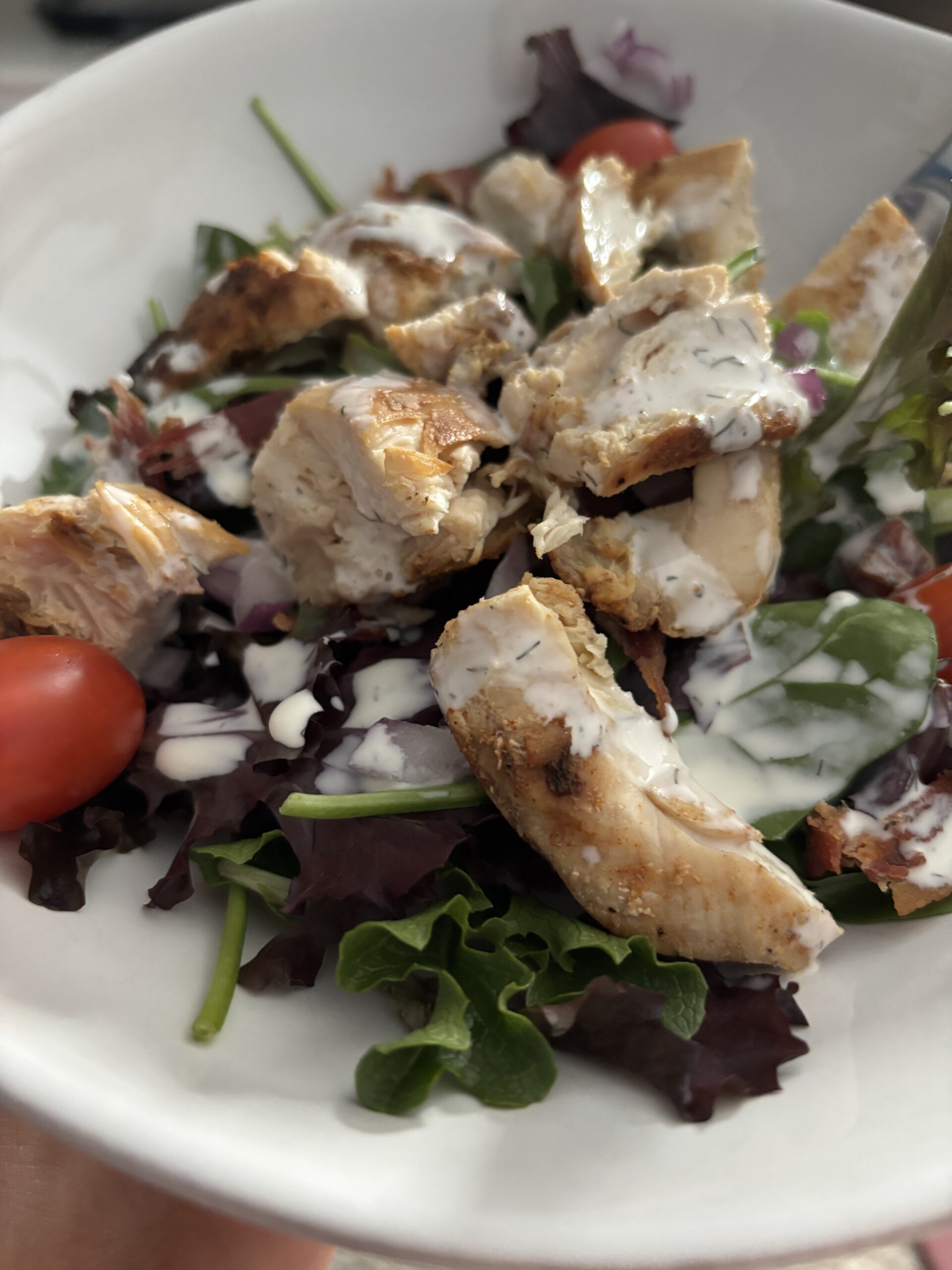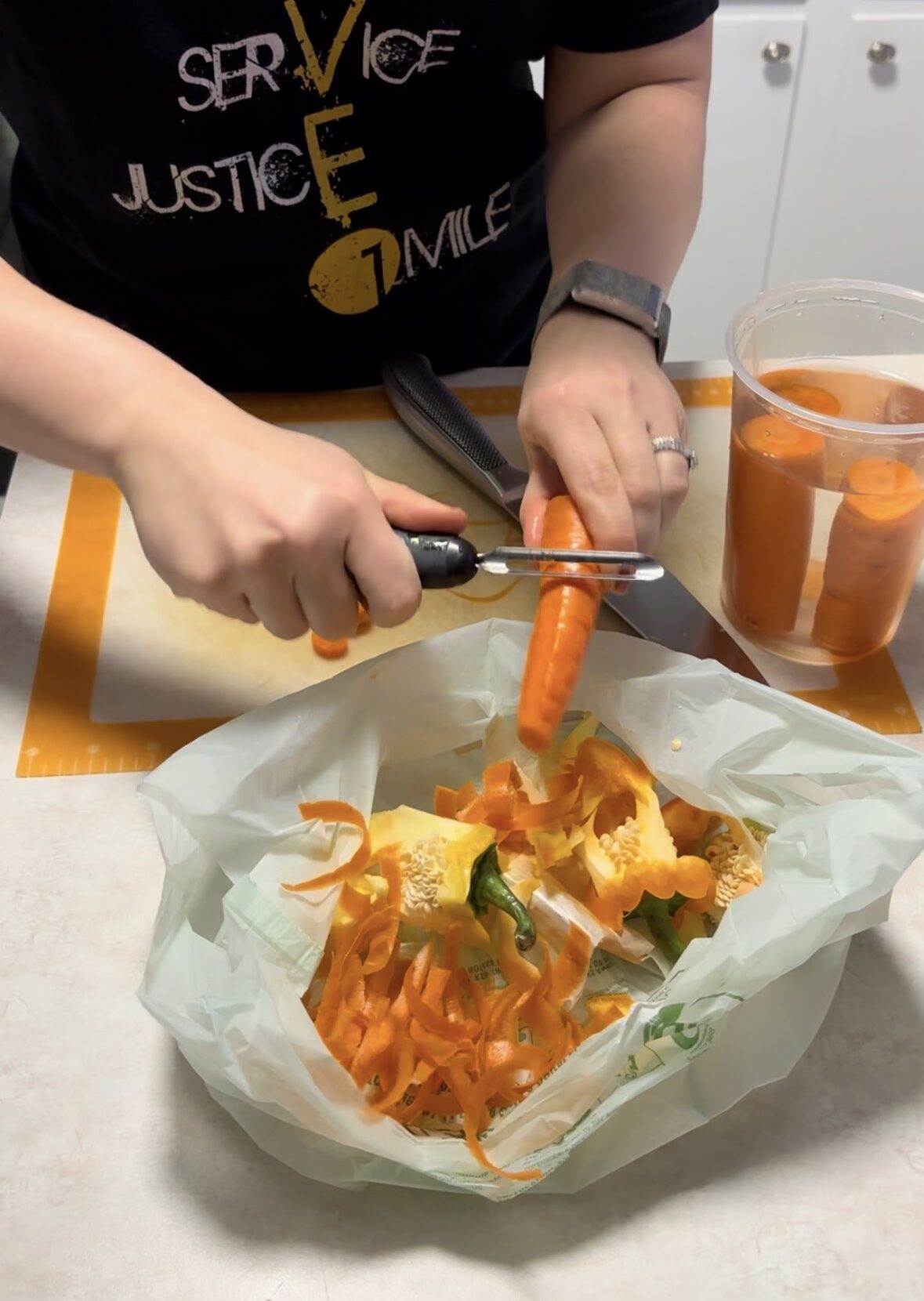Do you have a goal to eat healthier in 2025?
One of my favorite things about the holiday season is reflecting on the previous year and looking forward to the upcoming year by setting goals. Many people set goals or resolutions for their health, especially after a season filled with more food and sweets than typical.
I used to set health goals every year whether it was losing weight, sticking to a new diet, or starting a new fitness routine. But I never stuck to my goals for long. I wanted to lose weight, but that goal wasn’t specific enough detailing HOW I was going to lose the weight. The next year, I wanted to stick with a new diet, but the “diet” I wanted to stick to was too restrictive to fit into my life. Then, I wanted to start a new fitness routine because I thought it would make me thinner, not because I wanted to enjoy exercise, or become strong and capable.
Over these last few years I’ve gotten better at goal setting and building habits to meet my goals. My 2025 goals list has nothing about losing weight or starting a diet. The previous goals I’ve met and habits I’ve built are so sustainable they are just part of my everyday life now. I am the healthiest and fittest I’ve ever been. I want to share how you can make meaningful and sustainable changes in your journey towards healthier eating. Nothing in this blog post is considered medical advice! Please talk to your doctor before changing your diet patterns as each person is unique.
Progress is not linear
My personal healthy eating journey has been full of ups and downs. Sometimes I have a few weeks or months where I make choices that don’t make me feel my best. But because I have experienced many different phases of my healthy eating journey, I know how to get back to where I feel my best. As you go through your journey, it will take time, and there will be ups and downs. You will have days where you veer off the original plan, but don’t allow it to set you back or negatively affect the great progress you’ve made so far!

Before we get into the specifics of how to build a plan for your personal healthy eating journey, I wanted to share what made my healthy eating journey finally stick and feel sustainable. I stopped focusing on restrictions and what I couldn’t eat to “stay on track”. This mindset led to me eating something I wasn’t “supposed to” and feeling disappointed in myself. Instead, I reframed my perspective. I started to think about how eating healthy enabled me to not have stomach pain constantly, enabled me to feel confident, and will enable me to have the best chance at living (and hiking) into old age. Think about what healthy eating will enable you to do, and let that be your focus!
Step 1: Set a goal
As you start to think about your own healthy eating journey, think about your goals. This can be a broad, overarching goal you want to achieve. I’ll help you think about how to set more specific goals as we continue. Do you want to gain weight? Lose weight? Build a more aesthetic figure? Improve your gut health? Identify food sensitivities? Physically feel better? Mentally feel better? There are a ton of reasons why you may want to eat healthier. Really think about what your true motivation is, and write it down somewhere.
Step 2: Build your accountability network
Regardless of your overarching goal, you need an accountability plan. There are multiple ways you can form an accountability plan, so choose what will work best for you!
- If you need self-accountability, there are a few options.
- You can use an app to help you track your food, or your habits. I use My Fitness Pal to track my food. I don’t track all the time, but this is the app I use when I do. If you don’t want to track your food (calories and macros), you could also use a habit tracker to track things like servings of vegetables, or drinking a certain amount of water each day.
- You can use a food or habit tracking journal as well, if you’d prefer hand-written information. This may be more challenging to use consistently since the app can remind you when to fill out your information as opposed to a handwritten journal.
- Add reminders around your house in areas that may normally be tempting or in areas you want to spend more time. You could add a post-it note to your snack cupboard reminding you of your goals to improve your gut health and to eat more fiber so you choose the right snack. Or you could add a post-it note to your mirror reminding you of your goals to be strong and mobile in old age and to eat enough protein to maintain muscle mass.
- Hopefully your family and friends are supportive of the lifestyle changes you want to make, and you can rely on them for accountability as well. Having them on board will help you stick to your plans and achieve your goals.
- You could also hire a nutritionist, dietitian, or fitness coach. They will not only help you formulate a plan specific to you and your goals, they will also check in with you and be an additional source of accountability.
If you want to get straight to building a plan, feel free to skip over step 3. I love learning and part of my goal at Responsible Journey is to provide you with easy to understand education. I always want to know why things behave or function the way they do. For example, if someone tells me to not eat carbs by themselves for a snack, that’s not helpful to me. I want to know why. And once I understand why, it allows me to implement positive change more sustainably because I better understand the impact of the change.
Step 3a: Learn about macronutrients (“macros”)
If you’ve heard of “macros”, but don’t really understand them, let’s dig in. The three essential macronutrients (“macros”) are carbohydrates, protein, and fat. These three macros make up the bulk of the foods you consume each day. While most foods contain all macros, there is typically one primary macro per food. Let’s look at each briefly.
- Carbohydrates are converted to glucose by the body. Glucose is stored in the body as glycogen which is the main source of energy by the cells in our body. Simple carbs provide the quickest energy – sugar, honey, fruit juice, etc. Complex carbs take longer to break down into glucose and don’t provide energy quite as quickly – beans, spinach, sweet potatoes, etc. Because carbs are broken down and absorbed quickly, they can drastically affect your blood sugar. Having non-ideal blood sugar levels can lead to health problems like diabetes. Additionally, if carbs are over-consumed, the excess glycogen not used up as energy is converted to fatty acids, which are stored as fat in the body.
- Protein is broken down into amino acids, which your body requires to build muscle, and perform other critical functions. Protein can also be used by your body for energy, but not as easily as carbs. Protein helps your body feel more full than when you consume just carbs. You can consume protein through meat and seafood, or plant-based options like soy or beans.
- Fat is broken down into fatty acids. Fatty acids help absorb micronutrients from fruits and vegetables, and fat is important for brain health. Just like protein, fat can be used as energy and helps you feel full. Omega-3 fats provide the most health benefits, which you can get from things like olive oil, nuts, and seeds. Since fat also breaks down into fatty acids, if over-consumed these are also stored as fat in the body.

Step 3b: Learn about gut health
Gut health seems to be the trendiest new term in the wellness arena and there are countless cleanses and supplements to “improve” your gut health. This is a relatively new area of research, and there are still a lot of gaps. Your gut microbiome consists of your stomach, both intestines, and the tons of diverse bacteria and other microorganisms inside. Both good and bad bacteria exist in your gut. In general, you want more good bacteria and more diversity in the bacteria for improved gut health. Your gut health directly influences the health of your digestive system, nervous system, endocrine system, and immune system, so it’s pretty important!
You can help your gut health by consuming probiotics and prebiotics.
- Consume probiotics. Probiotics are live strains of bacteria you can ingest to help repopulate your gut with the good bacteria you need to thrive. The impact of probiotics depends on your original gut biome, as well as the amount and type you choose to ingest. Sounds gross, I know. You can get these types of bacteria through supplement form (I use SFI Health, previously Klaire Labs), or through ingesting fermented foods like yogurt, vinegar, kimchi, sauerkraut, etc.
- Consume prebiotics. Prebiotics essentially provide food for the existing bacteria in your gut to continue to grow. Prebiotics primarily come from fibrous foods in our diet like fruits, vegetables, and whole grains. You need to consume a wide variety of fibrous foods to supply our wide variety of bacteria with food. We all have our favorite fruits and veggies, but it’s important to diversify what you consume for the friendly bacteria in our gut! In the United States and Europe, it’s generally recommended for men to consume 30-38 grams of fiber per day and recommended for women to consume 21-25 grams of fiber per day. Only 4% of American men and 12% of American women consume enough fiber. Are you eating enough fiber? If you’re not sure, I’d recommend tracking your current fiber intake through an app like MyFitnessPal.
You can help your gut health by limiting your consumption of antibiotics and ultra-processed foods.
- Limit antibiotics. Antibiotics are a wonderful invention and sometimes they are absolutely necessary. Take antibiotics when you need them!! It’s important to be aware that consistently consuming antibiotics can disrupt your gut biome. If you’re working to improve your gut health, consider limiting your antibiotic consumption if possible.
- Limit ultra-processed foods (UPFs). UPFs are classified in this way because they contain ingredients not found in a kitchen (like high fructose corn syrup or aspartame for example). UPFs are associated with many health issues, but they also negatively affect your gut health because they typically don’t contain many probiotics or prebiotics. Without these, your gut health will decline. If it’s not good food for your gut microbes, it’s probably not good food for you!
Step 3c: Learn about blood sugar regulation
When it comes to feeling your best mentally and physically, you want to be cognizant of your blood sugar. When the food you eat is broken down to glucose, the glucose goes into your bloodstream, which provides your body with energy. Remember, glucose is the body’s primary source of energy!
Most people check their fasting blood sugar once a year (or less) and if it’s in the appropriate range, they don’t think about it again. Blood sugar levels are also what determines if someone has developed Type 2 diabetes (consistently high blood sugar). If you’ve been diagnosed with Type 2 diabetes, you are likely watching your blood sugar levels much more closely as it’s important to maintain the correct range throughout the day to avoid serious complications. The reality is that everyone’s blood sugar fluctuates a lot throughout the day, and it’s important for all of us, not just those of us with Type 2 diabetes.
So how do we manage our blood sugar? As a reminder, carbohydrates are the primary macronutrient that breaks down into glucose in our bloodstream. If you’ve ever eaten a primarily carbohydrate diet, it may feel like a rollercoaster. You’re hungry every few hours, you have super high energy and then you crash. Instead of eating a carbohydrate as a snack (like crackers, fruit, veggies, oatmeal, bagel) ensure you pair the carbohydrate with a protein and fat. Since your digestion system is working through all three macronutrients instead of just carbohydrates, this will slow the glucose release to your bloodstream. Fiber also slows the release of glucose into the bloodstream. Follow the same guidelines when you’re building meals. Stress (high cortisol levels) can also negatively affect your blood sugar, so it’s important to find ways to manage stress in your life.

Step 4: Build your healthy eating plan!
I’ve built a decision tree to help you marry your overall goals with a focused plan. You may decide that you have more than one change you want to make. If that’s the case, making every change at once is likely to lead straight to burnout. Think through what’s sustainable to you in your current season of life and start there! In the next section I’ll also share some tips for how to make healthy eating feel more manageable.

If you want to track your macros…
To calculate your macros, I would recommend using this TDEE (total daily energy expenditure) calculator. It takes your height, weight, and activity level into account and will calculate your maintenance calories and macro breakdown. Maintenance calories means the calories you should consume to maintain your current weight. If your goal is to lose weight, use the “cutting” breakdown or if your goal is to gain weight, use the “bulking” breakdown.
I don’t abide by my exact TDEE recommendations. Typically, I will use the TDEE calculator to help me choose my calorie and protein goal. Then I will adjust the carb and fat goals a few times to see what works best for me. Currently I am trying to lose a little bit of weight, so my calorie goal is around 1,700 and my macros are 128g protein, 149g carbs, and 66g fat. As another example, my husband (who is also trying to lose a little bit of weight) has a calorie goal of around 2,400 calories and his macros are 180g protein, 180g carbs, and 107g fat. It’s important to find the right balance of macros so I’m not hungry between meals and so I have enough energy to complete my workouts.
Please don’t use my or my husband’s macros! Everyone is different and has different requirements. If you find that you need to adjust your macros drastically, I’d recommend making small increases over time rather than a drastic change. For example, if you currently eat 60g of protein per day and you need to eat 120g, I’d work to ramp it up from 60 to 120 over the course of a few weeks or months.
If you want to try Whole30…
If you haven’t heard of Whole30, I talk about it more here since it was a huge part of my own healthy eating journey. Essentially you eliminate sugar, dairy, grains, legumes, and alcohol for 30 days. After the 30-day elimination, you go through a reintroduction period to determine if you have intolerances to any of these common inflammatory foods. It is not specific to you, but it’s based on common inflammatory foods determined through research.
The first week or two can be rough as you may deal with some withdrawal-like symptoms (headaches, fatigue, irritableness). Once you pass this stage the benefits are unmatched! I experienced less bloating, better mental clarity, less fatigue, no stomach pain, less mood swings, and more. It took me a few years to truly optimize my diet after Whole30, but Whole30 gave me the foundation I needed. Now I have sustainable eating habits. I don’t feel like I’m restricting myself, I know what foods will trigger a stomachache, I have sustained energy, and more.
If you want to try food sensitivity testing…
I had a food sensitivity test done by my functional health practitioner because I was struggling with consistent stomach issues. She coordinated the testing and the report showed some interesting results. I was sensitive to things like almonds and kiwis – never would have guessed this! I followed a strict protocol for 3 months where I didn’t eat anything I was sensitive to (I also avoided gluten, dairy, and sugar even though it didn’t show up for me, this was based on my practitioner’s recommendations). This was essentially a personalized, longer version of Whole30 to help “reset” my gut.
I have seen a lot of differing opinions on how reliable food sensitivity testing is, but I personally found it to be very helpful. I would recommend finding a functional health practitioner to discuss your concerns – they may or may not recommend this type of testing, but they will personalize any protocols and plans to you which is most important!
If you want to try making gradual changes to support your gut…
If Whole30 or a complicated functional medicine protocol seems overwhelming, you can make one change at a time. As an example, you could choose to eliminate alcohol for 30 days and see how that affects you. Journal what you’re eating and how you’re feeling throughout the 30 days. Then reintroduce alcohol on day 31 and see how you feel. Make a decision if it’s something you want to continue consuming and if so, how often. Once you’ve made this decision, move on to the next food group you suspect to have a sensitivity to like added sugar or dairy or gluten. You could also use this approach to cut out drinking soda or caffeine, or to add one additional serving of vegetables per day, or to start taking a probiotic supplement. Reference step 3b of this post to get more ideas – you get to choose!
If you want to regulate your blood sugar…
Reference step 3c for more information about blood sugar, but this is all about creating balanced meals and managing stress. To create a balanced meal or snack, ensure it incorporates protein, fat, and carbohydrates. Adding fiber to your meal or snack is another great way to regulate your blood sugar. You may have your own ways of managing stress through yoga, meditation, or therapy, but there are some specific things you can do to prevent cortisol spikes throughout your day. Below are some examples of balanced snacks and meals, along with tips to prevent spikes in cortisol.
Here are some balanced snack examples:
- Crackers + cheese + meat stick
- Fruit + greek yogurt + nuts or seeds
- Oatmeal + chia seeds + almond butter
Here are some balanced meal examples:
- Crockpot BBQ Chicken (protein), Roasted Fingerling Potatoes with Olive Oil (carbohydrate + fat), Steamed Broccoli + Carrots (carbohydrate)
- Scrambled Eggs (protein), Avocado (fat), Apple (carbohydrate)
- Marinated Baked Chicken (protein + fat), Roasted Sweet Potatoes (carbohydrate), Roasted Asparagus and Green Beans (carbohydrate)
And, here are ways to minimize cortisol spikes throughout the day:
- Take a short walk after eating to support digestion. Exercise uses up the glucose in the bloodstream.
- Your cortisol is already high in the morning; it’s what helps you wake up! Eating a balanced breakfast (protein, fat, and carbohydrate) soon after waking will keep the stress levels down in your body and help stabilize your blood sugar.
- Caffeine can also elevate your cortisol levels. It’s best to have caffeine after eating a balanced breakfast to minimize this disruption.
Step 5: Cut the excuses and find what works for YOU!
Maybe you’ve gone through this blog and you’ve formulated a plan for your goals, but it still feels overwhelming! I get it – there’s a lot to think about, and it will take time to find a sustainable diet that works for you. Let’s walk through some common excuses for not eating healthy along with some suggestions on how you can make this piece more manageable.
- “I don’t have time to eat healthy”
- I don’t mean to sound harsh, but we make time for what we prioritize. If healthy eating is not a top priority for you, you’ll never feel like you have enough time. Make it a non-negotiable.
- Purchase and use kitchen appliances that make it easier to prepare food. Consider a vegetable chopper, a crockpot or Instapot, an air fryer, or a toaster oven.
- Find 15 minutes to pre-plan what meals you are going to have during the week. If you know what you’re having, and the ingredients are in your house, you’ve already saved a lot of time!
- You don’t have to make complicated or fancy recipes. I have a list of favorite go-to crockpot recipes to use when I have a super busy week ahead.
- “Eating healthy is too expensive”
- You don’t have to shop at Whole Foods to purchase healthy food. Try Aldi, Costco, or your local farmer’s market.
- Check out your local grocery store’s sales! Stock up on healthy non-perishables when they’re on sale and build your weekly menu around the produce and meat on sale that week.
- Organic food may not be in your budget – and that’s okay! I personally would always choose non-organic produce over ultra-processed food.
- “I don’t know what foods are considered healthy”
- If you’re overwhelmed by reading ingredient labels, just go with meat, fruits, and vegetables!! You can’t go wrong there.
- Whole30 is a great option for this as well. The website has a ton of information to help you at the grocery store and very strict guidelines so you don’t have decision fatigue around every ingredient label – either you can have it or you can’t.
- You can also hire a personal trainer or personal nutritionist to help you personalize your dietary needs.
- “I can’t decide what to cook”
- Again, find 15 minutes to pre-plan what meals you are going to have during the week. It takes all the guesswork out of your meals after a long day at work.
- Check out my Pinterest page for healthy recipe ideas! I have pins for my Whole30 favorites as well as crockpot favorites.
- “I travel too much to eat healthy”
- If you’re traveling around during the day, consider bringing your lunch with you. Most gas stations (and even Panera bread!) have microwaves where you can heat up your food, or you could bring a cold salad in a lunch box with ice packs.
- Have a plan for on-the-go snack options. If you know you’ll be hungry between meals, bring healthy snacks!
- If you’re traveling away from home for a few days at a time, can you stay somewhere equipped with a kitchen so you can still cook some meals? If not, you can still make healthy choices at restaurants! Check the restaurant website for details on the ingredients they use, or ask your waiter. You may feel high-maintenance asking these questions, but prioritizing your health is important and worth a few extra minutes of their time.
It takes time!
Any major appearance or diet changes take time! It’s taken me years to build muscle and lose fat, and I’ve had a lot of ups and downs along the way. If your goal is to gain or lose weight, a few pounds a month is a great and realistic goal, especially if you’re lifting weights and gaining muscle. Muscle weighs more than fat, so you may be gaining muscle and losing fat without seeing much movement on the scale. It’s best to focus on non-scale victories (NSVs) like your clothes fitting better, having more energy throughout the day, or feeling more confident.
It took me approximately 7 years to build a sustainable diet that I truly love. I feel my best and I never feel like I am restricting myself now. Give yourself grace as you start this journey because it is indeed a journey and your progress will not be linear! You deserve to prioritize your health and well-being. You just need to make the decision, build a plan, find your accountability network and take action. I can’t wait to hear about your journey!
SOURCES:
- https://tdeecalculator.net/
- https://newsinhealth.nih.gov/2023/08/breaking-down-food#:~:text=These%20include%20proteins%2C%20carbohydrates%2C%20and,a%20balanced%20diet%20looks%20like
- https://pmc.ncbi.nlm.nih.gov/articles/PMC5622781/
- https://pmc.ncbi.nlm.nih.gov/articles/PMC7589116/
- https://pmc.ncbi.nlm.nih.gov/articles/PMC10498976/
- https://pmc.ncbi.nlm.nih.gov/articles/PMC10260459/
- https://pmc.ncbi.nlm.nih.gov/articles/PMC7399967/
- https://medlineplus.gov/bloodglucose.html#:~:text=It%20comes%20from%20the%20food,to%20be%20used%20for%20energy
- https://www.piedmont.org/living-real-change/natural-ways-to-balance-your-blood-sugar
- https://my.clevelandclinic.org/health/diseases/21501-type-2-diabetes
- https://www.who.int/news-room/fact-sheets/detail/diabetes
- https://www.rupahealth.com/post/a-functional-medicine-protocol-for-balancing-blood-sugar
- https://my.clevelandclinic.org/health/body/25201-gut-microbiome






